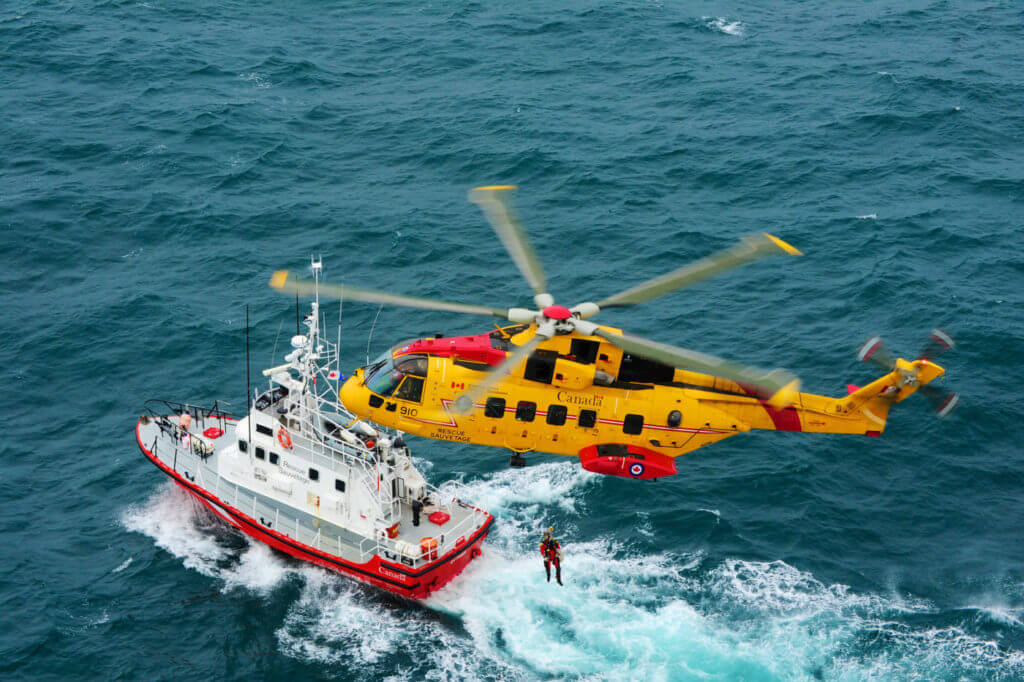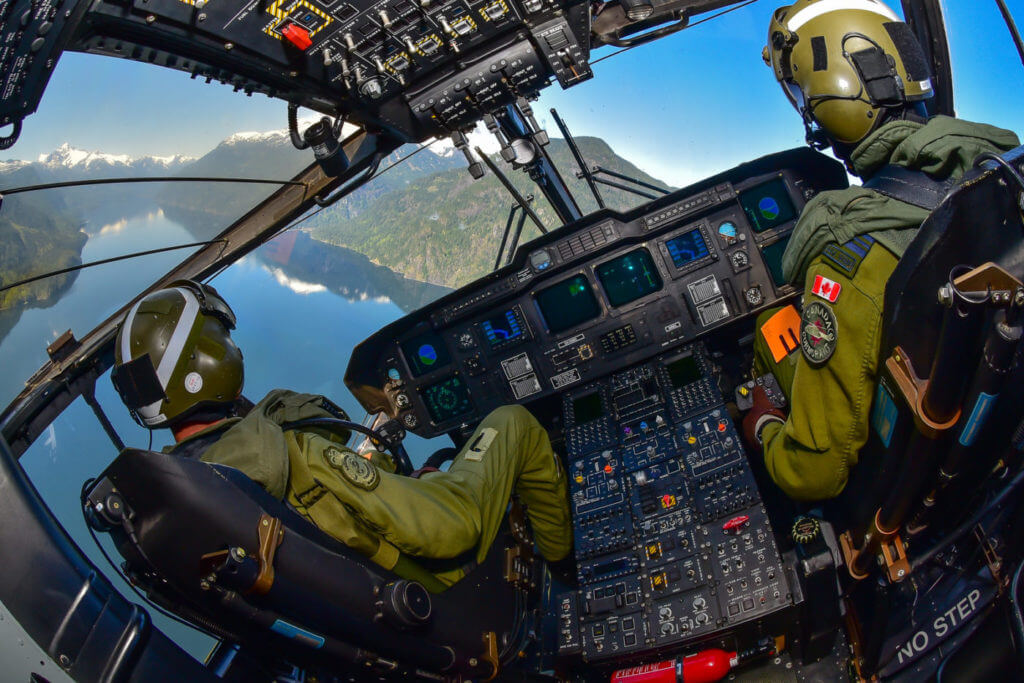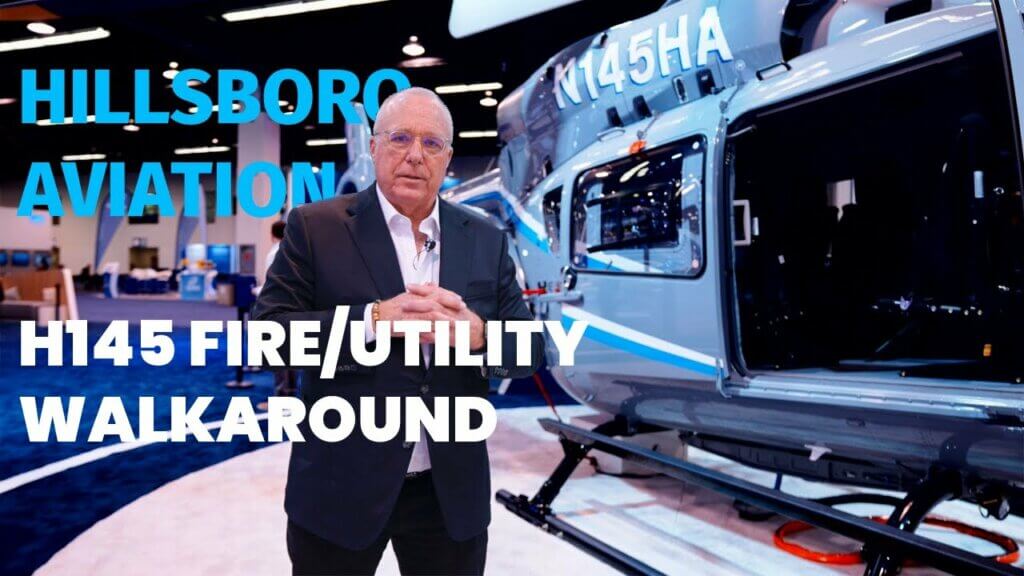The project is known as the Cormorant Mid-Life Upgrade (CMLU), but that doesn’t mean the eventual solution will necessarily be a Cormorant. Despite the name, helicopter manufacturers Sikorsky and Airbus see an opportunity to meet the Royal Canadian Air Force (RCAF) requirements with aircraft they believe are more effective and efficient.

As part of its helicopter search-and-rescue (SAR) fleet, the RCAF operates 14 CH-149 Cormorants, a variant of the Leonardo AW101, from three bases in Gander, Newfoundland, Greenwood, Nova Scotia, and Comox, British Columba, and augments that with five yellow-painted smaller CH-146 Griffon helicopters from Trenton, Ontario.
The Cormorants first entered service in 2002 and today average over 5,000 flight hours per airframe. The RCAF would like to extend the life of the fleet to 2040, but after 16 years of yeoman work in often extreme conditions, the helicopters are facing concerns about parts obsolescence and availability.
Until the release of the government’s defence policy last June, the upgrade plan was one of many on a lengthy list of unfunded projects. But with money and top-level support from the policy, the Air Force has impetus to move it forward. At an industry outlook in April, senior officials said they would be presenting options “within the next months.”
While the policy has “brought clarity” to the fleet recapitalization project, the RCAF will be looking to industry for input on “what makes the most sense to achieve the mandate that CMLU has,” BGen Michel Lalumiere, director general for Air Force Development, told Vertical in a recent interview.
The project, estimated at up to $1.5 billion, is currently in what the military calls options analysis. But the core requirements include addressing current and forecasted obsolescence issues, meeting current and forecasted regulatory requirements, enhancing the CH-149 SAR capability, and delivering aircrew training with a new simulation system. It also includes a desire to return the Cormorant capability to Trenton, suspended in 2005 because of delays in implementation and demand in the other locations.
As a result, all options to address the current and future operational requirements for the Cormorant fleet are being assessed, a senior officer said at the outlook hosted by the Canadian Association for Defence and Security Industries (CADSI).

Among the many questions that will be posed to industry is exactly how many SAR-configured helicopters are required to meet the high tempo of operations from all four bases. “We’re asking industry to come up with those numbers and what method then do we bring those extra aircraft [into service],” said Lalumiere.
Leonardo has proposed modernizing the Cormorant fleet based on the Norwegian All-Weather Search and Rescue Helicopter (NAWSARH) program, which was selected in 2013 to replace an aging fleet of Sea King aircraft. The first helicopter was delivered in November 2017.
The upgrades would include new cockpit displays, avionics, digital automatic flight control system, aircraft management system, electro-optical surveillance system, an obstacle proximity LiDAR system, and weather radar as well as a new 3,000 horsepower CT7-8E engine. Leonardo is also offering mobile phone detection technology that would allow an onboard system to identify and track a mobile phone within a 25-mile range.
To boost the size of the fleet from 14 to 21, Leonardo has proposed converting seven VH-71 airframes, airworthy variants of the AW101 that were acquired from the U.S. government in 2011 for spare parts, to the same configuration. The additional aircraft would allow the Air Force to return the Cormorant to 424 Transport and Rescue Squadron at 8 Wing Trenton, which currently operates the Griffons over the largest SAR region in the country.
While the Air Force has been intrigued by the VH-71 conversion proposal, then-RCAF commander LGen Mike Hood told Vertical in 2016 that repair and maintenance costs of the extant fleet would need to be reduced before he’d move ahead with the plan. “I believe once we get there, the conditions will be set for me to drive forward with the Cormorant mid-life update and I want to see the VH-71s included in that,” he said. “But until such time as they can deliver on what the department has asked in the way of reducing cost, I’m a little stuck.”
In an interview last May, John Ponsonby, managing director for Leonardo Helicopters, acknowledged the issue and said the company and its in-service support partner, IMP Aerospace, “have committed to a significant program of cost reduction and we have delivered a significant percentage of cost reduction already.”
At the April industry outlook, an Air Force official described the first stages of a new sustainment business cases analysis on the CH-149. She said it builds on an earlier “optimization review” in which the two companies “proposed a new approach to materiel support and component repair and overhaul services” that included “a savings target.”

To date, “innovation and efficiency resulted in an overachievement of savings and a reduced cost of ownership” that has not compromised fleet availability.
All options on the table
Without the benefit of a formal request for information or proposals, helicopter manufacturers are understandably cautious about speculating on possible requirements. But both Sikorsky, a division of Lockheed Martin, and Airbus are keen to see the project become an open competition.
Raffi Fattal, Sikorsky’s regional sales director for the United States and Canada, acknowledged that the primary option on the table remains an upgrade to the existing Cormorant fleet. However, “we also understood that other options were being looked at: replacement aircraft, new aircraft of another type, augmentation to the existing fleet, or a mix thereof,” he said.
“We looked at this understanding that the defence department has put out a mandate where they are looking really hard at efficiencies and commonality going forward,” said Glenn Copeland, business development director for Lockheed Martin Canada’s rotary and mission systems. “Knowing that they have challenges with existing cost structures associated with the EH-101 … we saw a very good opportunity.”
If the project does go to competition, Sikorsky would offer the S-92 in a SAR configuration, an off-the-shelf platform currently used by Ireland, the United Kingdom and other SAR providers.
“The S-92 is the ‘go to’ SAR helicopter, operating in the harshest environments around the world,” he noted. “The S-92 platform is reliable and robust-it’s a workhorse. In Canada, S-92s have flown over 100,000 hours since 2006 and demonstrated the endurance and range requirements needed to operate effectively in Canada’s large maritime and interior areas. It’s conducting missions … in the North Sea area [for U.K. SAR] over long distances, harsh environments, and low visibility, so the aircraft has proven itself in that regard.”
Airbus, on the other hand, would offer the H225, part of the Super Puma family that is in service with multiple search and rescue providers. Airbus calls the helicopter “a reference in SAR operations” due in part to a quick takeoff sequence of less than five minutes, all-weather capability, and extra long-range with auxiliary fuel tanks.

“We strongly believe it is premature to rule out all other non-Cormorant based options and hope we will have the opportunity to offer alternatives,” said Mark Conroe, director of government and military sales for Airbus Helicopters Canada.
That could include a new aircraft fleet or a lease option “where the aircraft are contractor owned and operated by the Royal Canadian Air Force,” he said, adding that a leased fleet “would fall within the budgetary parameters of maintaining and operating the current fleet.”
Above all, though, both companies are touting their availability rate and operating costs.
The global S-92 fleet claims an availability rate consistently above 95 percent, said Fattal. And performance data from U.K. SAR health and usage monitoring systems shows a rate of between 98 and 99 percent.
“With a SAR mission, that is a paramount requirement, to have that aircraft ready to go when it is needed … with no delay. It has exceeded in that regard,” he said.
Airbus didn’t provide a rate, but Conroe said the “H225 has the lowest operating costs in its class and a useful load which is at or near the best in its class.”
That could be hard for the Air Force to ignore — the CH-149 has been an expensive aircraft to operate. While proposed sustainment changes could significantly improve Cormorant lifecycle costs, both Airbus and Sikorsky believe they can achieve around 50 per cent savings.
Conroe said data analyzed by Conklin and de Decker show the operating costs per flight hour for the H225 “are approximately 32 per cent less than those for a commercial variant of the Cormorant.”
Moreover, information obtained from Public Accounts of Canada found the total variable operating costs for 2015 for the Cormorant to be $6,650 per flight hour, “reported costs [that] exceed projected costs for the H225 during the same year by over 50 percent,” he said. The same information revealed that for the years 2013 to 2016, “the average contract cost for the CH-149 in-service support contract was $185 million, rising to $300 million in 2016. We can provide aircraft, services, and a simulator below those rates moving forward, with a modern helicopter operating more efficiently than the current fleet and with higher operational availability.”
Based on third-party analysis of U.K. SAR data, Sikorsky also claims to be “at least 50 percent of the cost per hour to operate the S-92 compared to the incumbent,” said Fattal.

As to the question of how many helicopters might be required to fulfill the mission from four main operating bases, Fattal said Sikorsky would need to see the RCAF’s final requirements but noted that with an availability rate of over 98 percent, “you require much fewer aircraft per base than what our competition would propose … so our solution would be a very efficient and slimmed down total fleet size if you were to compare it to what the incumbent has now.”
“Given the availability rate of the H225, our assessment is 15 SAR-configured aircraft would be able to handle the mission,” said Conroe. “The H225 would return operational availability to a level where it will not be necessary to augment the current fleet with additional aircraft.”
Both companies would offer turn-key training solutions and would seek to leverage existing relationships with the RCAF. Airbus won the fixed-wing search-and-rescue competition in 2016 with the CC-295 and, together with CAE and a joint venture with PAL Aerospace called AirPro, will build, maintain and deliver the courses for a SAR training centre in Comox.
The CH-148 Cyclone, a militarized variant of the S-92, will reach initial operating capability with the Royal Canadian Navy later this year, and could serve as a reason to develop some common aircrew and technician training. Compatibility between the SAR and maritime helicopters might also improve fleet management.
Fattal noted that the S-92 was designed with the military requirements of the UH-60 Black Hawk in mind, “so tolerance to damage, ease of maintenance in the field, these things were factored into the S-92, which makes it a very easy aircraft to maintain. You certainly don’t need a large crew of maintainers to keep the S-92 flying.”
Both companies also emphasized that they have active production lines and could have new helicopters in service in a relatively short period — 12 to 14 months in the case of the S-92 U.K. SAR variant.
As intriguing as the options might be, Lalumiere cautioned that any alternative to the Cormorant could not create a people problem for the small force. “The people aspect is a huge challenge, especially if it’s on high readiness. SAR is on high readiness,” he said.
Quoting LGen Hood, he said the Air Force would steer clear of any platform that requires “a very long and very tough transition for the 25 to 30 operational crews that I have doing the business today.”
Lalumiere also stressed that although other manufacturers might claim better performance metrics, the Air Force knows the costs and capability of the current fleet and has a well-established relationship with Leonardo and IMP on the program.
While both parties believe the performance can be better, the RCAF would approach any numbers cautiously and would need to define with industry which data to use in a procurement.










The Cormorant was a mistake from day one, and the Canadian Government seems to be on route to doing it again. It doesn’t take a rocket scientist to figure it out.
DND already operate Sikorsky (S92) and adding to that number equipped for SAR would only save money in spare parts acquisitions, crew training + maintenance training costs.
The Chinooks are a beautiful helicopter but are being protected by off the shelf 412’s which can’t keep up with them in flight.
Get rid of the 412’s and buy BlackHawks with side mounted missiles and can carry more troops in utility configuration.
Then you would only have Sikorsky & Chinook air/maintenance crews to train.